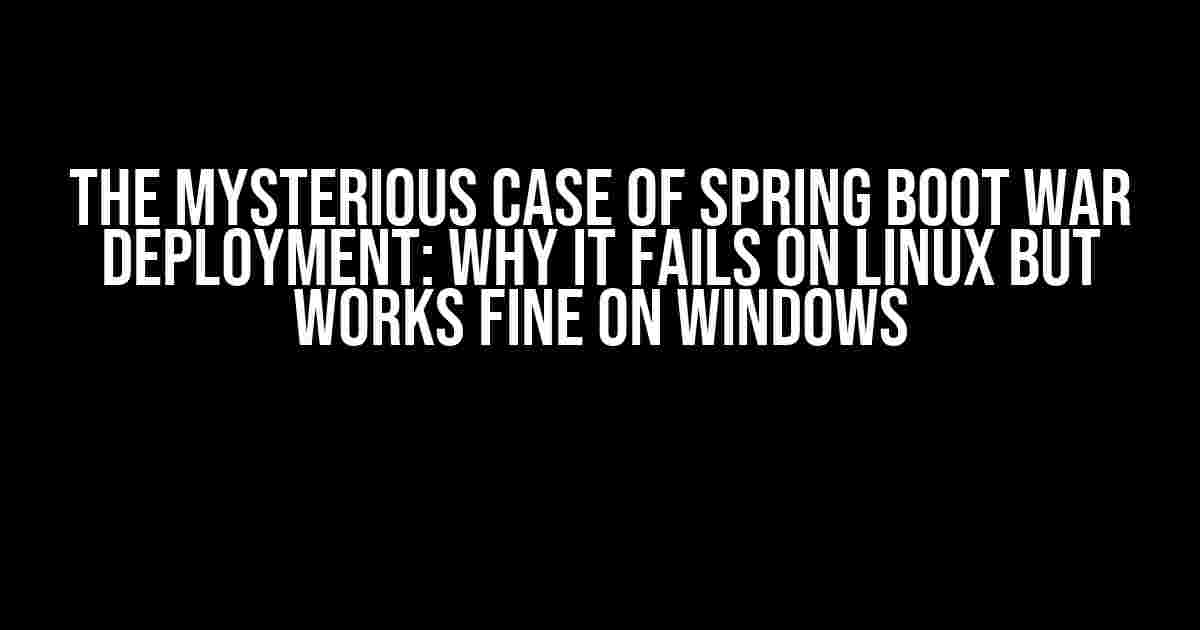Are you tired of banging your head against the wall, trying to figure out why your Spring Boot WAR deployment fails miserably on Linux, but works like a charm on Windows? You’re not alone! In this article, we’ll delve into the depths of this frustrating issue, exploring the possible causes and providing step-by-step solutions to get you back on track.
Understanding the Problem
Before we dive into the troubleshooting process, let’s take a step back and understand the issue at hand. Spring Boot is a popular framework for building web applications, and WAR (Web Application Archive) is a common deployment format. Tomcat, being a popular servlet container, is often the go-to choice for deploying WAR files. So, what goes wrong when we try to deploy our Spring Boot WAR on Tomcat in a Linux environment, but not on Windows?
Key Differences Between Windows and Linux Environments
Let’s highlight the main differences between Windows and Linux environments that could contribute to this deployment disparity:
- File System:** Linux is case-sensitive, whereas Windows is not. This can lead to issues with file naming conventions and path resolutions.
- Environment Variables:** Linux and Windows have different methods for setting and accessing environment variables.
- Dependency Management:** Linux packages and dependencies might not be identical to their Windows counterparts.
- Server Configuration:** Tomcat configuration files and startup scripts differ between Linux and Windows.
Troubleshooting Steps
Now that we’ve identified the potential differences, let’s follow a systematic approach to troubleshoot and resolve the deployment issue:
Step 1: Verify WAR File Integrity
Ensure your WAR file is correctly generated and contains all necessary dependencies. You can do this by:
- Running the command `jar -tvf your-war-file.war` to list the contents of the WAR file.
- Verifying that the WAR file contains the expected Spring Boot dependencies, such as `spring-boot-starter-web` and `tomcat-embed-core`.
Step 2: Check Tomcat Configuration
Tomcat configuration issues can cause deployment problems. Check the following:
- Ensure the Tomcat `server.xml` file is correctly configured for your Linux environment.
- Verify the Tomcat `catalina.properties` file contains the correct settings for your WAR file.
- Check the Tomcat log files for any error messages or warnings related to your WAR file deployment.
Step 3: Environment Variable Setup
Environment variables can affect deployment. Ensure you’ve set the following variables correctly in your Linux environment:
JAVA_HOME: Pointing to the correct Java installation directory.CATALINA_HOME: Set to the Tomcat installation directory.CATALINA_BASE: Set to the Tomcat base directory.
Step 4: Dependency Management
Dependency issues can cause deployment failures. Verify that you’ve installed the correct dependencies for your Linux environment:
- Java Development Kit (JDK) or Java Runtime Environment (JRE)
- Tomcat native libraries (e.g., `libtomcat-native-1.2.26.so`)
- Other dependencies required by your Spring Boot application
Step 5: Server Configuration
Tomcat server configuration might need adjustments for your Linux environment. Check the following:
- The Tomcat `server.xml` file contains the correct `
` element for your WAR file. - The Tomcat `web.xml` file is correctly configured for your Spring Boot application.
- Verify that the Tomcat `conf` directory contains the correct configuration files for your WAR file.
Common Issues and Solutions
While troubleshooting, you might encounter specific issues. Here are some common problems and their solutions:
| Issue | Solution |
|---|---|
| Error: “Failed to deploy WAR file: java.lang.NoClassDefFoundError: org/springframework/boot/web/servlet/filter/RegistrationBean” | Verify that the `spring-boot-starter-web` dependency is included in your WAR file. |
| Error: “Failed to deploy WAR file: java.lang.ClassNotFoundException: org.apache.catalina.startup.Tomcat” | Check that the Tomcat native libraries are installed and correctly configured. |
| Error: “Failed to deploy WAR file: org.springframework.boot.autoconfigure.web.ErrorMvcAutoConfiguration” | Verify that the `spring-boot-starter-web` dependency is included in your WAR file and that the `ErrorMvcAutoConfiguration` is correctly configured. |
Conclusion
Deploying a Spring Boot WAR file on Tomcat in a Linux environment can be a daunting task, but by following these troubleshooting steps and addressing common issues, you should be able to overcome the hurdle. Remember to verify WAR file integrity, check Tomcat configuration, set environment variables correctly, manage dependencies, and adjust server configuration as needed. With persistence and attention to detail, you’ll be able to successfully deploy your Spring Boot application in a Linux environment.
Note: This article is intended to provide general guidance and troubleshooting steps. The specific solutions may vary depending on your project's requirements and environment. Be sure to adapt and tailor the recommendations to your unique situation.
By following this comprehensive guide, you’ll be well on your way to resolving the “Spring Boot WAR failed to deploy in Tomcat on Linux” conundrum. Happy troubleshooting!Here are 5 Questions and Answers about “Spring boot war failed to deploy in tomcat on Linux environment while it works fine on Windows”:
Frequently Asked Question
Get answers to the most frequently asked questions about deploying Spring Boot WAR files on Linux environment with Tomcat.
Why does my Spring Boot WAR file fail to deploy on Tomcat in Linux environment but works fine on Windows?
This could be due to the difference in file system casing between Windows and Linux. In Windows, file system is case-insensitive, whereas in Linux, it’s case-sensitive. Ensure that the WAR file name and the Tomcat configuration files have the correct casing to resolve the deployment issue.
What are the specific Tomcat configuration files I need to check for case-sensitivity issues?
Verify the server.xml, context.xml, and web.xml files in the Tomcat configuration directory for correct casing. Also, check the WAR file name and the file path specified in the Tomcat manager or server.xml file for any case-sensitivity issues.
Can permissions issues cause deployment failures on Linux environment?
Yes, permissions issues can cause deployment failures on Linux. Ensure that the Tomcat server process has the necessary permissions to read and write to the deployment directory. Run the command `chmod 755 /path/to/deployment/directory` to set the correct permissions.
How can I troubleshoot the deployment issue on Linux environment?
Enable debug logging in Tomcat by setting the `LogLevel` to `DEBUG` in the logging.properties file. This will provide more detailed error messages to help you identify the root cause of the deployment issue. You can also check the Tomcat server logs and the deployment directory for any error messages or warnings.
Can I use a different deployment method, such as using a jar file instead of a WAR file, to avoid deployment issues on Linux?
Yes, you can use a different deployment method, such as using a jar file with an embedded Tomcat server, to avoid deployment issues on Linux. This approach can simplify the deployment process and reduce the chances of case-sensitivity or permissions issues. However, this may require additional configuration and setup.


